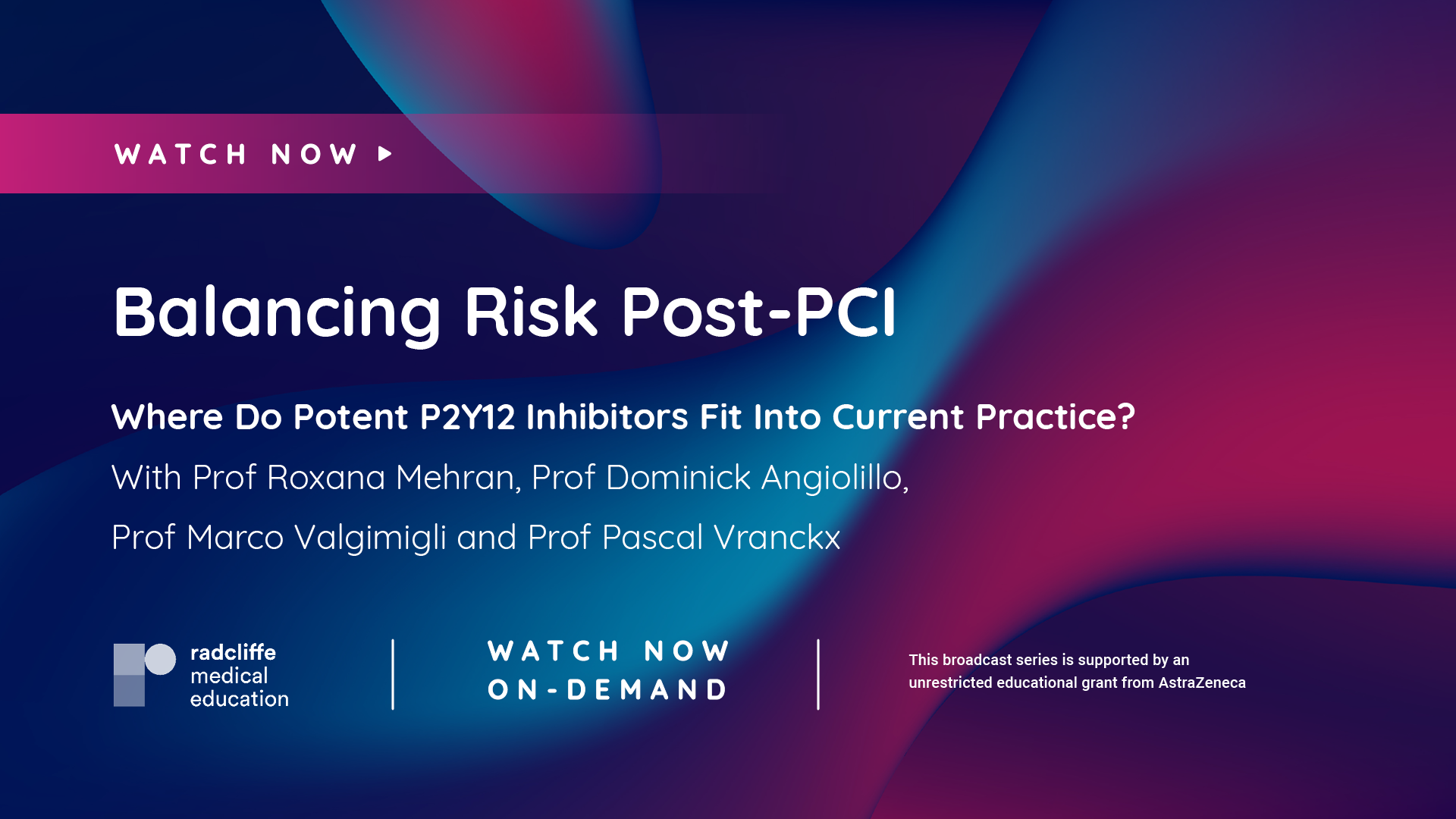Where Do Potent P2Y12 Inhibitors Fit Into Current Practice? - Balancing Risk Post-PCI
Published: 13 October 2022
-
Views:
 16515
16515
-
Likes:
 7
7
-
Views:
 16515
16515
-
Likes:
 7
7
-
 18m 3sPart 1 Clinical Vignette and Panel Discussion Marco Valgimigli, Roxana Mehran, Dominick J Angiolillo, Pascal Vranckx
18m 3sPart 1 Clinical Vignette and Panel Discussion Marco Valgimigli, Roxana Mehran, Dominick J Angiolillo, Pascal Vranckx
-
 13m 35sPart 2 Assessing Bleeding Risk Post-PCI Roxana Mehran
13m 35sPart 2 Assessing Bleeding Risk Post-PCI Roxana Mehran
Overview
This broadcast series 'Where Do Potent P2Y12 Inhibitors Fit Into Current Practice?' will reappraise potent P2Y12 inhibitors, as evidence accumulates to support their broader use. At this juncture, there is still some uncertainty around patient selection, initiation and long-term management.
The third broadcast in this series, focused on Balancing Risk Post-PCI. In this on-demand version of the live broadcast, Radcliffe Medical Education brings together a global faculty of experts in the field to look at current guidance, the landmark data, gaps in evidence and seeks to provide practical guidance.
Prof Roxana Mehran (Mount Sinai Hospital, New York, US) chairs the proceedings, and is joined by Prof Dominick Angiolillo (University of Florida College of Medicine-Jacksonville, US), Prof Marco Valgimigli (Instituto Cardiocentro Ticino, Lugano, CH) and Prof Pascal Vranckx (University of Hasselt, BE) for a series of insightful presentations and discussions.
You can also catch up on other broadcasts in this series:
Key Learning Objectives
Following the completion of this programme, physicians will be in a position to:
- Apply the use of validated bleeding risk tools across a wide range of patients
- Use guidelines and clinical judgement to select antiplatelet therapy regimens in patients at elevated bleeding risk
- Recall the clinical significance of trial data assessing truncated periods of DAPT
- Prescribe confidently in patients judged to be at elevated bleeding risk
- Recall the safety profiles of different P2Y12 inhibitors
Target Audience
- General Cardiologists
- Interventional Cardiologists
- Nurses and any other allied HCPs
More from this programme
Part 1
Clinical Vignette and Panel Discussion
Part 2
Assessing Bleeding Risk Post-PCI
| 1 session | |
| Assessing Bleeding Risk Post-PCI | Watch now |
Part 3
Optimum Duration of DAPT: Overview of Current Data
Part 4
Bleeding Risk Mitigation - Safety in Clinical Practice and Panel Discussion
Faculty Biographies

Dominick J Angiolillo
Professor & Chief
Dr Dominick Angiolillo graduated from the Catholic University of the Sacred Heart Medical School in Rome, Italy and pursued training in interventional cardiology at the Complutense University of Madrid in Spain and received his Ph.D. in cellular and molecular cardiology. Dr Angiolillo is board-certified in internal medicine, cardiovascular disease and interventional cardiology.
In 2004, Dr Angiolillo joined the University of Florida College of Medicine in Jacksonville, where he is a professor of medicine, director of cardiovascular research and director of the interventional cardiology fellowship program.
Dr Angiolillo has made major scientific contributions to many medical and cardiovascular journals, as well as cardiovascular medicine textbooks. He has authored more than 400 peer-reviewed articles, with nearly 30,000 citations and an H-index of 86. He has authored more than 30 book chapters and is the editor of his…





